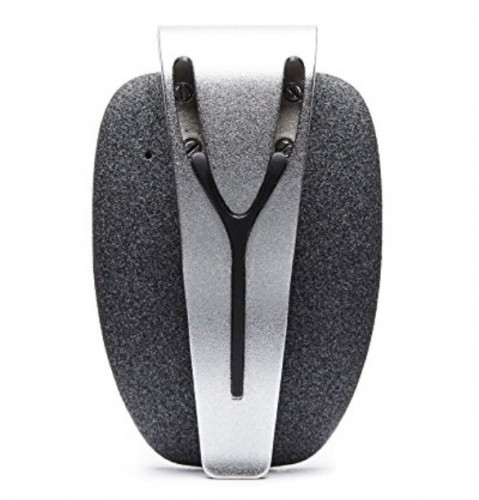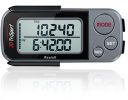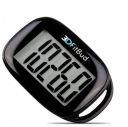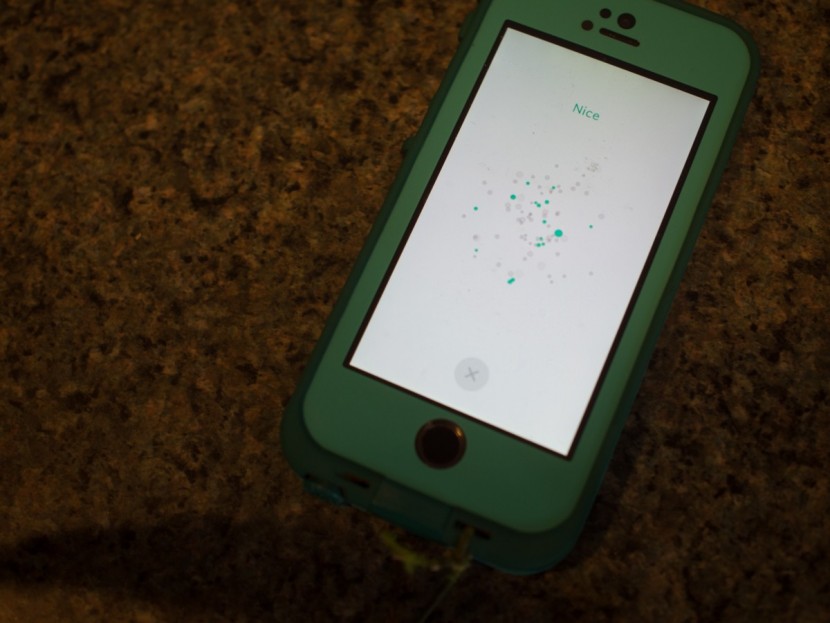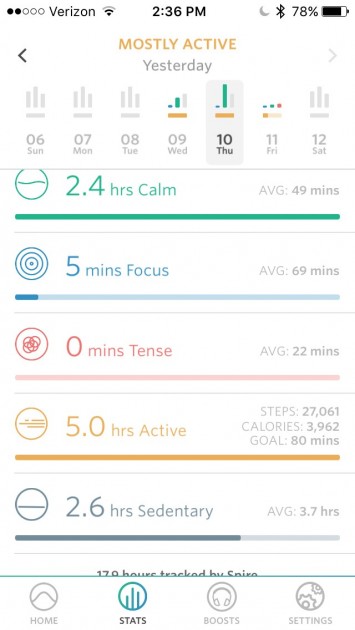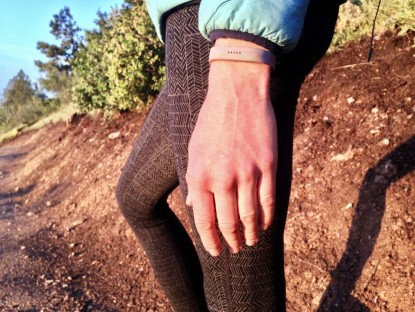The Spire Stone represents an evolutionary jump in wearable technology. This device makes a bid to track both your movements and your breath, which it uses as a proxy to determine the state of your mind. If you are breathing slowly and regularly, it records that you're relaxed. If you start hyperventilating, it'll mark you down as stressed. Go figure. At its most basic, the Spire is your typical step counter. It uses accelerometer technology to count strides. It also uses that accelerometer, to limited effect, to monitor your breathing. All this data is tracked and recorded in an associated phone app. The phone app further parses that data, mainly the breathing data, to estimate your mood and stress level.
Finally, the app can work with the breathing information to provide a sort of guided meditation. While the device itself isn't anything special, it is the specialized data processing and inspiration that the app provides that sets it apart. Execution isn't perfect, but the idea is great and the function sound enough to earn our Top Pick award alongside the also quite specialized Bellabeat Leaf and the super-simple CSX Simple Walking 3D.Spire Stone Review
Our Verdict
Compare to Similar Products
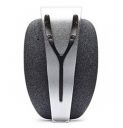 This Product
Spire Stone | |||||
|---|---|---|---|---|---|
| Awards | Best for Mindfulness Practice | Best Self-Contained Unit | |||
| Price | $80 List | $25 List $24.99 at Amazon | $35 List | $25 List $23.99 at Amazon | $27 List |
Overall Score  |
|||||
| Star Rating | |||||
| Bottom Line | Monitors activity and breathing to provide uniquely effective guided meditations | An affordable, extensive, and autonomous pedometer with no need for a smartphone | An inexpensive, comprehensive pedometer for those that don’t need/want data managed on a smartphone app | The simplest sort of pedometer | A product that collects all the information that most will want, without the complication of a phone app |
| Rating Categories | Spire Stone | Realalt 3D TriSport | OZO Fitness SC2 Dig... | 3DFitBud Simple Ste... | Omron Alvita Optimized |
| Depth of Data (20%) | |||||
| Data Management (20%) | |||||
| Accuracy (20%) | |||||
| Ease of Use (20%) | |||||
| Portability (20%) | |||||
| Specifications | Spire Stone | Realalt 3D TriSport | OZO Fitness SC2 Dig... | 3DFitBud Simple Ste... | Omron Alvita Optimized |
| % Accuracy | 94.4 | 99.1 | 90.8 | 97.3 | 99.2 |
| Battery Life | 7 days | Up to 1 year | Approx. 1 year | Approx. 1 year | Information not available |
| Tracks Distance in addition to steps? | No | Yes | Yes | No | Yes |
| Needs additional device? | Yes, syncs with smartphone | No | No | No | No |
| Sync Style | Syncs automatically and wirelessly | No | n/a | n/a | n/a |
| Tracks Heart Rate? | No | No | No | No | No |
| User-entered data? | Yes | Yes | No | No | No |
| Automatically enters sleep mode? | Yes | N/A | N/A | Yes | N/A |
Our Analysis and Test Results
The Spire takes the back door into our review. While it is serviceable as a pedometer, it is branded and marketed as a breath tracker. Ironically we found the Spire's breath tracking somewhat limited but found the pedometer function to be very useful. This is the only non-gender-specific breath tracker we were able to find on the market. For anyone looking to track both breathing and activity, in addition to mindfulness prompts and sleep exercises, the Spire is a truly unique product.
As a pedometer, the Spire is fairly average. Some products were far more refined in their step counting and activity tracking attributes. However, the way this device pairs breath and activity tracking with its corresponding app coalesce to help the user improve their mindfulness and meditative practice. As such, the Spire is in a class of its own. For this reason, in spite of the Spire's mediocre overall score, we granted the Spire a Top Pick award in the hope that folks will consider as an ideal option for monitoring both mindfulness practice and tracking daily activity levels.
Depth of Data
In testing the capacity of the Spire as a pedometer, this device performed unexceptionally. Some products are far more refined in their pedometer and activity tracking attributes. However, with the help of the Spire's breath-tracker, in addition to the device's capacity as a pedometer, the Spire excels as a tool to inspire greater mindfulness and meditative practice. The device and associated app converge to help the user step-up their meditation game leaving the Spire in a class of its own. Due to the Spire's capacity as a mindfulness coach, in spite of the device's underwhelming performance in some of our tester's ratings, we awarded the Spire a Top Pick award. Read on to learn more about how this device can help you reduce stress and increase awareness.
The Spire and corresponding app aim to be a holistic device and activity tracker. While moving, the Spire tracks activity and steps. Then when the user is in traffic, meetings, doing work, or actively meditating — the Spire tracks your breath. This data, coupled with the device's capacity to track sleep quality as well as one's caloric intake and mood (if you take the time to upload your meal and mood data) allows you to monitor stress, anxiety, wellness, and mindfulness over time. All this data, coupled with the device's unique ability to track breathing patterns can help the user better understand and manage stress or anxiety. In addition to the ubiquitous step count, the Spire can be used to approximate one's sleep quality, breathing rate, and calories consumed.
The Spire is similar to the other Top Pick Bellabeat Leaf and the Editor's Choice Fitbit Flex 2 in terms of depth of data. Each of these devices goes above and beyond the average pedometer. In addition to simple step counting, the corresponding apps for the Spire, Leaf, and Flex 2 provide the user with a robust depiction of overall wellness and health. The Spire and the Leaf both track breathing patterns to help users manage stress in addition to activity tracking. The apps that come with the Flex 2 and the Leaf can be used as period-trackers. The Spire, the Flex 2, and the Fitbit Zip Wireless can be used to track caloric intake. All of the aforementioned devices can provide additional data for the user who wishes to upload personal information.
The Spire is similar to the Leaf and the Flex 2 in that it integrates other health information with movement data. However, the Spire is unique in that it monitors breath to construct a daily narrative about your mood and overall health so that you can work to better manage stress and anxiety. Are you curious about how stress corresponds to your eating & exercise habits? The Spire can be used to help you better understand how you cope with stress, and the corresponding mindfulness coaching can help you develop better-coping strategies in high-stress situations. If you're looking for a device to encourage a better meditative practice, the Spire can be used simply for this. However, with the input of user data and daily wear — the Spire can be used as an overall wellness and health tracker.
Data Management
The Spire uses what has become a classic data management strategy. The device itself holds a battery, accelerometer, and Bluetooth antenna. There is no display on the apparatus. The raw data collected by the Spire is sent via Bluetooth to your smartphone where the app processes your data. The one issue we had with the data management of the Spire is that the device only holds 6 hours of data at a time. If your phone is turned off, distant, with the app closed, or Bluetooth is disabled, data beyond six hours will be lost. While we became accustomed to this fact, we lost a fair amount of Spire movement data.
The overall Data management style of the Spire is quite similar to that of the Bellabeat Leaf, and the Fitbit Flex 2. None of these products display data on the device itself, instead relying on a synced smartphone app for activity tracking. Think of the Spire as a sensor that collects and delivers information for viewing on your smartphone.
Accuracy
The accuracy of step count is the simplest and most objective assessment we deploy in our review of pedometers. Since we are testing step-counting devices, to compare the accuracy of other functions is irrelevant. Nonetheless, we can anecdotally report on the apparent accuracy of the other data collected. In neither way did the Spire deliver impressive performance. First, in our repeatable step count test, the Spire was less accurate than most. The good news is that given that most step counters prove relatively inaccurate absolute accuracy doesn't matter.
If you consistently wear your device in the same place each day and are fairly reliable in your stride-length or non-exercise movement patterns, the daily step counts will correspond to your actual activity. It is relatively insignificant that the Spire records an average of approximately 6% more steps a person may take when walking in a straight-line. Similarly, the breath tracking often seemed out-of-sync with actual breathing, however, the device does provide an approximate and comparable measure of your breathing to guide activity and stress management. Like many methods for quantitative data assessment, enough rough data can be parsed to give valuable insights, regardless of the proven accuracy of the individual data points.
Ease of Use
The Spire is easy enough to use. Modern consumer electronics have come a long way in the last decade or so. Like many other pedometers, the Spire simply needs to be charged, synced with the phone app. Once downloaded, the app walks you through the initial set-up, offering tutorials on how to use the device. We found it intuitive and simple, much like the other app-enabled devices. Of course, the simplest products are those that do not require smartphone syncing. However, these trade ease of use for less robust data management systems.
The Spire relies completely on a smartphone app for data tracking, akin to the Fitbit Flex 2, Fitbit Zip Wireless, and the Bellabeat Leaf. These devices are slightly less easy to use than devices that provide an on-device activity-tracking function. The absolute easiest product we tested was the CSX Simple Walking 3D, which is a standalone device that simply counts steps continuously until you reset it. The display readout is quite large, and there is only one button which resets the device. For ease of use, nothing beats the CSX.
Portability
The Spire is average in terms of bulkiness. However, this is just one aspect of the portability assessment. However, the Spire is unique in that it captures breathing information. To track breath, the manufacturer recommends the device be clipped either to a waistband or a bra strap. Placed anywhere else, the device won't capture breath information with a great degree of accuracy. Since breath tracking sets the Spire apart, we followed the manufacturer's instructions in our testing. For step counting, we are confident that the Spire could be carried in a user's pants pocket. The construction is robust, and the clip seems relatively secure; however, we lost one of our test samples in routine use, which is a rather unsatisfactory state of affairs, and significantly affects our assessment of the portability and value of the Spire.
No other product we tested was as limited in how you can carry it as the Spire. Given the relatively-flimsy nature of the attachment clip - the device was lost during testing. All the others can be clipped on or carried loose in your pants pocket. This is a relatively significant difference. Our lead test editors prefer carrying pedometers in their pants pocket. Clipped carry seems both vulnerable and a little dorky.
Disregarding the dork-factor, the clipped carry of the Spire did indeed fulfill his worst expectations and fell off somewhere in a routine day of walking around.
Best Applications
For breath tracking and assisting with mindfulness exercises, nothing beats the Spire.
Value
For specialized functions like the Spire performs, we expect to pay at least a little more. However, a significant variable in the value of the Spire is that we lost our first test sample. To replace an expensive piece of electronics like this is extremely undesirable, to put it mildly. We wish the clip were more secure or that there were other options for attaching the Spire.
Conclusion
As a truly unique breath tracker, the Spire is a great pedometer for specialized applications. The ease with which the device comes detached from one's waistband is alarming, but perhaps Spire can address this in subsequent iterations.


